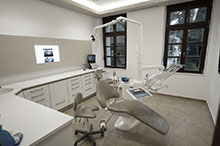Surgical Extractions
A dental extraction (also referred to as tooth extraction, exodontia, exodontics, or historically, tooth pulling) is the removal of teeth from the dental alveolus (socket) in the alveolar bone. Extractions are performed for a wide variety of reasons, but most commonly to remove teeth which have become unrestorable through tooth decay, periodontal disease or dental trauma; especially when they are associated with toothache. Sometimes wisdom teeth are impacted (stuck and unable to grow normally into the mouth) and may cause recurrent infections of the gum (pericoronitis). In orthodontics if the teeth are crowded, sound teeth may be extracted (often bicuspids) to create space so the rest of the teeth can be straightened.
Semi-impacted Wisdom Tooth
A wisdom tooth or third molar is one of the three molars per quadrant of the human dentition. It is the most posterior (most distal) of the three. Wisdom teeth generally appear between the ages of 17 and 25. Most adults have four wisdom teeth (a third molar in each of the four quadrants), but it is possible to have fewer or more, in which case the extras are called supernumerary teeth.
Wisdom teeth commonly affect other teeth as they develop, becoming impacted or semi-impacted. They are often extracted when this occurs.
If a tooth is semi-impacted (half buried in the bone), a surgical or trans alveolar approach may be required, which is performed under local anesthetic and involves cutting the gum away and removal of the bone which is holding the tooth in with a surgical drill. After the tooth is removed in one or more pieces, stitches are used to replace the gum into the normal position.
“Wisdom Teeth”. American Association of Oral and Maxillofacial Surgeons. Retrieved 2010-09-28. “This generally occurs between the ages of 17 and 25”Impacted Wisdom Tooth
A wisdom tooth or third molar is one of the three molars per quadrant of the human dentition. It is the most posterior (most distal) of the three. Wisdom teeth generally appear between the ages of 17 and 25.[1] Most adults have four wisdom teeth (a third molar in each of the four quadrants), but it is possible to have fewer or more, in which case the extras are called supernumerary teeth.
Wisdom teeth commonly affect other teeth as they develop, becoming impacted or semi-impacted. They are often extracted when this occurs.
If a tooth is impacted ( buried in the bone), a surgical or trans alveolar approach may be required, which is performed under local anesthetic and involves cutting the gum away and removal of the bone which is holding the tooth in with a surgical drill. After the tooth is removed in one or more pieces, stitches are used to replace the gum into the normal position
“Wisdom Teeth”. American Association of Oral and Maxillofacial Surgeons. Retrieved 2010-09-28. “This generally occurs between the ages of 17 and 25”
Semi-impacted Wisdom Tooth
Impacted Wisdom Tooth
Treatments
The Office

This is a modern dental clinic, with high-end equipment, adapted to the requirements of modern medicine in the dental field.




